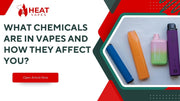
If you’ve ever picked up a vape pen and wondered, “What Chemicals Are in Vapes and What exactly is going into my body right now?” — you’re not alone. A lot of people make the switch to vaping thinking it’s just “flavoured water vapour,” but the truth isn’t that simple. Vapes don’t contain the thousands of toxins that come with cigarettes, yes, but they’re not just harmless mist either.
What you’re actually inhaling is a cocktail of nicotine, solvents, flavourings, and a handful of trace chemicals that behave very differently once heated. Some are relatively safe, others… not so much. Let’s break it down properly.
The Main Ingredient: Nicotine
We can’t talk about vapes without starting with nicotine. It’s the star of the show, the one thing that keeps people coming back for another puff. Most vape juices are built around this compound.
Nicotine itself isn’t what directly causes cancer, but it’s still highly addictive and messes with your body in a bunch of ways so it’s the main chemical when discussing What Chemicals Are in Vapes?.
-
It raises your heart rate and blood pressure.
-
It changes how your brain releases dopamine, which is why it’s so addictive.
-
Over time, it can affect sleep, mood, and even how your body handles stress.
Some juices come in nicotine salts, which hit faster and feel smoother. Others use freebase nicotine, which is harsher but gives a stronger throat hit. Either way, it’s nicotine — and if you’re vaping it, you’re playing with an addictive substance.
Propylene Glycol (PG): The Carrier
Next up, propylene glycol. Sounds scary, right? But PG is actually pretty common — it’s in toothpaste, cough syrups, even some foods. In vaping, it’s used to help carry flavour and create that “throat hit.”
The thing is, PG isn’t entirely innocent. Breathing it in regularly can dry out your mouth, throat, and even make some people feel irritation. In high concentrations, it might trigger allergies or asthma-like symptoms. Nothing too crazy for most users, but worth knowing.
Vegetable Glycerin (VG): The Cloud Maker
If PG is about throat hit, VG is all about the clouds. This thicker, sweeter liquid makes those dense vapour clouds that cloud-chasers love. VG is also used in food and cosmetics, so it’s not toxic in itself.
But — and here’s the kicker — when you heat VG too much, it can break down into compounds like acrolein, which is irritating to lungs and not something you want a lot of in your system. That’s why coil temperature and how you vape matter more than most people think.
Flavourings: The Wild Card
Here’s where things get messy regarding What Chemicals Are in Vapes. Vape liquids come in every flavour under the sun — mango ice, strawberry milkshake, custard cream, cola fizz. To make that happen, manufacturers use food-grade flavourings. Eating these chemicals? Usually fine. Inhaling them? That’s a different story.
One of the most infamous examples is diacetyl, which gives a buttery taste. Safe in popcorn. But when workers inhaled it in popcorn factories, it caused “popcorn lung” — a serious lung condition. Most reputable brands avoid diacetyl now, but not every manufacturer is transparent.
Other flavouring agents, when heated, can turn into aldehydes or compounds that irritate lung tissue. The science is still catching up, but one thing’s clear: just because a chemical is safe to eat doesn’t mean it’s safe to inhale every day.
Other Additives and Metals
Apart from the main liquids, vapes can carry traces of metals — nickel, tin, lead — usually coming from the coil or tank materials. These don’t always show up in big amounts, but with repeated use, there’s a chance you’re inhaling small bits of heavy metals.
Some studies have also detected formaldehyde and acetaldehyde in certain vapes, especially when devices are overheated. These are known carcinogens, but again, levels vary a lot depending on the device, liquid, and how it’s used.
It’s not the same as smoking, but it’s not completely “clean” air either.
Short-Term Effects on the Body
So, what actually happens when you vape and What Chemicals Are in Vapes? In the short term, most people feel:
-
A nicotine buzz (lightheadedness, relaxation, focus).
-
Dry mouth and throat.
-
Occasional coughing, especially with high-PG liquids.
-
Increased heart rate after a few puffs.
For people with asthma or lung sensitivity, vaping can trigger flare-ups. It’s not usually as harsh as smoking cigarettes, but it’s definitely not neutral.
Long-Term Risks: What We Know (and Don’t Know Yet)
Here’s the honest bit — vaping hasn’t been around long enough for us to fully understand every long-term consequence. Cigarettes have been studied for decades; vapes are still relatively new. But researchers have spotted a few worrying patterns:
-
Lung irritation: Chronic exposure to heated flavourings and solvents might contribute to respiratory issues.
-
Cardiovascular stress: Nicotine puts the heart under pressure, no matter the delivery method.
-
Cell damage: Some vape chemicals show signs of oxidative stress, which can, over time, play into bigger health risks.
Do vapes cause cancer? Right now, the evidence is limited, but we can’t say they’re risk-free. The absence of proof is not the proof of absence, if you get what we mean.
How They Compare to Cigarettes
Now, let’s put this in perspective. Cigarettes contain over 7,000 chemicals, many of them toxic, with at least 70 known carcinogens. Vapes? Far fewer. That’s why most experts agree vaping is less harmful than smoking.
But less harmful doesn’t mean harmless. Think of it like this: swapping fast food for home-cooked meals is better, but if you’re still eating loads of fried stuff, it’s not exactly a health plan.
A Note from Heat Vapes
At Heat Vapes, we’ve seen first-hand how the vaping world keeps evolving. New devices, new liquids, new research — it’s a space that never stands still. Our aim is to give people honest information, not sugar-coated promises. Whether you’re a seasoned vaper or just curious about making the switch, we believe knowledge is power.
Vaping might not be perfect, but making informed choices about what you put into your body? That’s always the smarter move.
What Chemicals Are in Vapes: Hidden Risks Explained
When most people pick up a vape for the first time, the thought running through their head is usually simple: “Well, at least it’s not a cigarette.” And fair enough — e-cigs don’t churn out tar, don’t stink up your clothes, and don’t pump thousands of toxic by-products into your lungs with every drag.
But here’s the part fewer people talk about: those little bottles of e-liquid aren’t just “flavoured mist.” They’re made of real chemicals, some benign, some questionable, and a few that raise eyebrows once you start digging into the research.
Vaping might be less harmful than smoking — science leans that way — but “less harmful” doesn’t automatically mean “harmless.” If you care about What Chemicals Are in Vapes, it’s worth looking closely at what actually goes into a vape cloud and how those ingredients behave once heated.
The Usual Suspect: Nicotine
We can’t avoid it. Nicotine is the backbone of most vape liquids. Whether it’s in freebase form or blended as nicotine salts, it’s the part that keeps you coming back for “just one more puff.”
Now, nicotine doesn’t directly cause cancer — let’s set that straight. But it’s addictive to the core and comes with its own package of health effects: raised heart rate, higher blood pressure, disrupted sleep, and that twitchy cycle of craving and satisfaction.
In the long run, it can alter how your brain handles stress and reward, which is why quitting can feel like fighting your own wiring.
Propylene Glycol (PG): More Than Just a Carrier
You’ll see this one on almost every bottle: propylene glycol, or PG. If the name rings a bell, that’s because PG is used in food, medicine, even cosmetics. In vapes, it helps carry flavour and provides that sharp little “hit” in the throat.
Here’s the kicker though: while PG is generally recognised as safe when eaten, inhaling it day after day isn’t the same thing. For many, it causes dry mouth or a scratchy throat. People with asthma sometimes find PG vapour irritating. It’s not deadly stuff, but it’s not plain water either.
Vegetable Glycerin (VG): The Cloud Builder
The other base liquid is vegetable glycerin (VG). Sweeter, thicker, and responsible for those dense, Instagram-worthy clouds. VG is also food-grade and widely used in sweeteners and skincare.
But when heated, VG can break down into by-products like acrolein — a compound known to irritate the lungs and eyes. The hotter the coil, the higher the chance of creating things you don’t want swirling around in your lungs.
So while VG isn’t inherently “toxic,” the way it’s used in vaping changes the story.
Flavourings: The Real Wild Card
Here’s where things get murky. Flavours are what make vaping fun, right? Strawberry ice, custard cream, mango punch — they turn nicotine into something palatable. But these flavourings were designed to be eaten, not inhaled.
Take diacetyl, for example. It creates a buttery taste and is perfectly fine in food. But when factory workers breathed it in at high levels, it caused a severe lung condition that earned the nickname “popcorn lung.” Most good vape brands now avoid diacetyl, but not every manufacturer is as strict as they should be.
Beyond diacetyl, certain flavourings can produce aldehydes and other reactive chemicals when heated. The science here is still evolving, but researchers agree on one thing: inhaling heated flavour chemicals every day is not the same as eating them occasionally in food.
Metals and Hidden Extras
Something people rarely consider: the device itself can add contaminants. Vape coils are often made from metals like nickel, tin, or even traces of lead. Over time, and especially with cheap or poorly built devices, tiny amounts of these metals can leach into vapour.
In small doses, maybe not catastrophic — but in constant exposure, metals aren’t what you want floating into your lungs.
Then there’s the risk of formaldehyde and acetaldehyde showing up, particularly if you’re vaping at high wattages or running coils too hot. These are known irritants, with formaldehyde classified as a carcinogen. Levels vary wildly, but the potential is there.
What Happens to Your Body in the Short Run
So, you take a puff. What actually happens? For most vapers:
-
Nicotine hits the brain within seconds, delivering focus, calm, or a buzz depending on your tolerance.
-
PG and flavourings dry out the throat and mouth.
-
Some people cough, especially with high-PG mixes or strong flavours.
-
Heart rate and blood pressure tick upward for a while.
It’s a quick cycle — stimulation, satisfaction, then back to craving. And while the effects might feel mild compared to smoking, they’re still measurable.
Long-Term Questions That Don’t Have Clear Answers
Here’s the tricky bit. Vaping hasn’t been around long enough for us to see its full long-term health picture. Cigarettes had decades of research piling up against them. Vapes are still the new kid on the block.
But early signs aren’t completely rosy:
-
Respiratory irritation from long-term exposure to heated flavourings.
-
Cardiovascular strain from ongoing nicotine use.
-
Cell damage linked to oxidative stress from certain chemicals.
None of this proves vaping equals cancer. What it does prove is that calling vaping “harmless” is jumping the gun.
How Vaping Stacks Up Against Smoking
Now, to be fair: traditional cigarettes are a chemical nightmare — over 7,000 compounds, with around 70 proven carcinogens. Vapes, by comparison, contain a fraction of that mess. That’s why most public health bodies admit vaping is likely less harmful than smoking.
But “less harmful” is a sliding scale. It’s like swapping fast food for home-cooked fries: better than a greasy takeaway, sure, but still not salad.
Why Transparency Matters
The real challenge with vaping is inconsistency. Some brands follow strict safety standards, test their liquids, and cut out dodgy chemicals. Others don’t. And because the industry isn’t universally regulated in the same way as tobacco, the onus is on the consumer to choose wisely.
This is where knowledge makes all the difference. Understanding that every puff contains not just flavour but a mix of nicotine, PG, VG, additives, and possibly metals helps you make an informed choice.
Vaping is complicated. On one hand, it spares you from the absolute chemical onslaught of smoking. On the other, it introduces its own set of risks — some known, some still being uncovered.
The hidden risks lie in the everyday chemicals: the solvents, the sweeteners, the flavourings designed for your taste buds but not your lungs. They don’t make vaping the villain cigarettes are, but they do keep it firmly in the “use with caution” camp.
Conclusion
At Heat Vapes, we believe straight talk matters especially on What Chemicals Are in Vapes. We’re based in Manchester and built our reputation by offering honest advice alongside quality vape products.
Not everything we discuss here is available on our shelves — our goal isn’t just selling, but helping people understand what they’re really inhaling.
Because when it comes to your lungs, blind trust isn’t an option. If you’re going to vape, do it with open eyes and the clearest picture of what’s inside that cloud.











